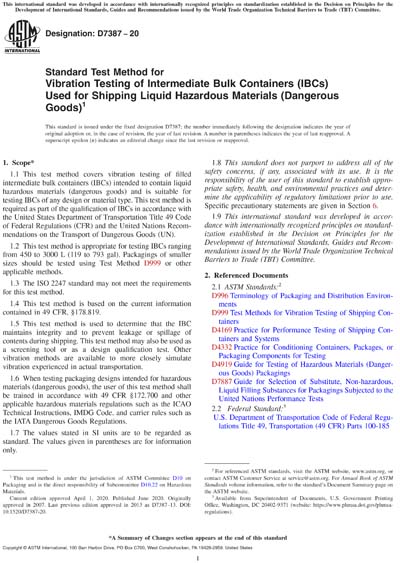Most recent
ASTM D7387-20
Standard Test Method for Vibration Testing of Intermediate Bulk Containers (IBCs) Used for Shipping Liquid Hazardous Materials (Dangerous Goods)
1.1 This test method covers vibration testing of filled intermediate bulk containers (IBCs) intended to contain liquid hazardous materials (dangerous goods) and is suitable for testing IBCs of any design or material type. This test method is required as part of the qualification of IBCs in accordance with the United States Department of Transportation Title 49 Code of Federal Regulations (CFR) and the United Nations Recommendations on the Transport of Dangerous Goods (UN).
1.2 This test method is appropriate for testing IBCs ranging from 450 to 3000 L (119 to 793 gal). Packagings of smaller sizes should be tested using Test Method D999 or other applicable methods.
1.3 The ISO 2247 standard may not meet the requirements for this test method.
1.4 This test method is based on the current information contained in 49 CFR, §178.819.
1.5 This test method is used to determine that the IBC maintains integrity and to prevent leakage or spillage of contents during shipping. This test method may also be used as a screening tool or as a design qualification test. Other vibration methods are available to more closely simulate vibration experienced in actual transportation.
1.6 When testing packaging designs intended for hazardous materials (dangerous goods), the user of this test method shall be trained in accordance with 49 CFR §172.700 and other applicable hazardous materials regulations such as the ICAO Technical Instructions, IMDG Code, and carrier rules such as the IATA Dangerous Goods Regulations.
1.7 The values stated in SI units are to be regarded as standard. The values given in parentheses are for information only.
1.8 This standard does not purport to address all of the safety concerns, if any, associated with its use. It is the responsibility of the user of this standard to establish appropriate safety, health, and environmental practices and determine the applicability of regulatory limitations prior to use. Specific precautionary statements are given in Section 6.
1.9 This international standard was developed in accordance with internationally recognized principles on standardization established in the Decision on Principles for the Development of International Standards, Guides and Recommendations issued by the World Trade Organization Technical Barriers to Trade (TBT) Committee.
Content Provider
ASTM International [astm]






